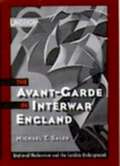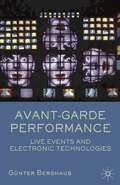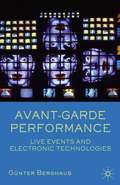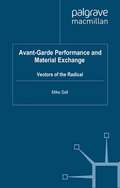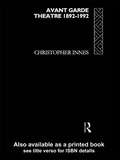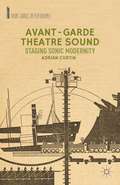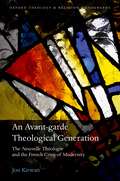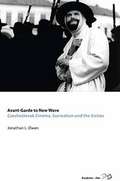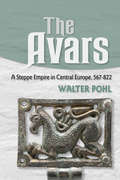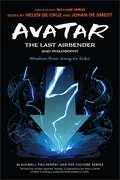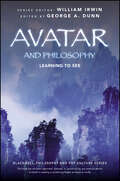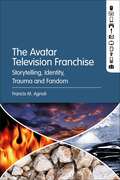- Table View
- List View
The Avant-Garde in Interwar England: Medieval Modernism and the London Underground
by Michael T. SalerThe Avant-Garde in Interwar England addresses modernism's ties to tradition, commerce, nationalism, and spirituality through an analysis of the assimilation of visual modernism in England between 1910 and 1939. During this period, a debate raged across the nation concerning the purpose of art in society. On one side were the aesthetic formalists, led by members of London's Bloomsbury Group, who thought art was autonomous from everyday life. On the other were England's so-called medieval modernists, many of them from the provincial North, who maintained that art had direct social functions and moral consequences. As Michael T. Saler demonstrates in this fascinating volume, the heated exchange between these two camps would ultimately set the terms for how modern art was perceived by the British public. Histories of English modernism have usually emphasized the seminal role played by the Bloomsbury Group in introducing, celebrating, and defining modernism, but Saler's study instead argues that, during the watershed years between the World Wars, modern art was most often understood in the terms laid out by the medieval modernists. As the name implies, these artists and intellectuals closely associated modernism with the art of the Middle Ages, building on the ideas of John Ruskin, William Morris, and other nineteenth-century romantic medievalists. In their view, modernism was a spiritual, national, and economic movement, a new and different artistic sensibility that was destined to revitalize England's culture as well as its commercial exports when applied to advertising and industrial design. This book, then, concerns the busy intersection of art, trade, and national identity in the early decades of twentieth-century England. Specifically, it explores the life and work of Frank Pick, managing director of the London Underground, whose famous patronage of modern artists, architects, and designers was guided by a desire to unite nineteenth-century arts and crafts with twentieth-century industry and mass culture. As one of the foremost adherents of medieval modernism, Pick converted London's primary public transportation system into the culminating project of the arts and crafts movement. But how should today's readers regard Pick's achievement? What can we say of the legacy of this visionary patron who sought to transform the whole of sprawling London into a post-impressionist work of art? And was medieval modernism itself a movement of pioneers or dreamers? In its bold engagement with such questions, The Avant-Garde in Interwar England will surely appeal to students of modernism, twentieth-century art, the cultural history of England, and urban history.
Avant-garde Performance
by G. BerghausHow did the concept of the avant-garde come into existence? How did it impact on the performing arts? How did the avant-garde challenge the artistic establishment and avoid the pull of commercial theatre, gallery and concert-hall circuits? How did performance artists respond to new technological developments? Placing key figures and performances in their historical, social and aesthetic context, Günter Berghaus offers an accessible introduction to post-war avant-garde performance. Written in a clear, engaging style, and supported by text boxes and illustrations throughout, this volume explains the complex ideas behind avant-garde art and evocatively brings to life the work of some of its most influential performance artists.Covering hot topics such as multi-media and body art performances, this text is essential reading for students of theatre studies and performance.
Avant-garde Performance: Live Events And Electronic Technologies (PDF)
by Günter BerghausHow did the concept of the avant-garde come into existence? How did it impact on the performing arts? How did the avant-garde challenge the artistic establishment and avoid the pull of commercial theatre, gallery and concert-hall circuits? How did performance artists respond to new technological developments? Placing key figures and performances in their historical, social and aesthetic context, G#65533;nter Berghaus offers an accessible introduction to post-war avant-garde performance. Written in a clear, engaging style, and supported by text boxes and illustrations throughout, this volume explains the complex ideas behind avant-garde art and evocatively brings to life the work of some of its most influential performance artists. Covering hot topics such as multi-media and body art performances, this text is essential reading for students of theatre studies and performance.
Avant-Garde Performance and Material Exchange: Vectors of the Radical (Performance Interventions)
by Mike SellAssembling a remarkable group of scholars, these essays explore how the circulation and exchange of 'vectors of the radical' shape the avant-garde. Mapping the movement of scripts, theatre activists, performances, and other material entities, they provide unprecedented perspectives on the transnational performance culture of the avant-garde.
Avant Garde Theatre: 1892–1992
by Christopher InnesExamining the development of avant garde theatre from its inception in the 1890s right up to the present day, Christopher Innes exposes a central paradox of modern theatre; that the motivating force of theatrical experimentation is primitivism. What links the work of Strindberg, Artaud, Brook and Mnouchkine is an idealisation of the elemental and a desire to find ritual in archaic traditions. This widespread primitivism is the key to understanding both the political and aesthetic aspects of modern theatre and provides fresh insights into contemporary social trends. The original text, first published in 1981 as Holy Theatre, has been fully revised and up-dated to take account of the most recent theoretical developments in anthropology, critical theory and psychotherapy. New sections on Heiner Muller, Robert Wilson, Eugenio Barba, Ariane Mnouchkine and Sam Shepard have been added. As a result, the book now deals with all the major avant garde theatre practitioners, in Europe and North America. Avant Garde Theatre will be essential reading for anyone attempting to understand contemporary drama.
Avant Garde Theatre: 1892–1992
by Christopher InnesExamining the development of avant garde theatre from its inception in the 1890s right up to the present day, Christopher Innes exposes a central paradox of modern theatre; that the motivating force of theatrical experimentation is primitivism. What links the work of Strindberg, Artaud, Brook and Mnouchkine is an idealisation of the elemental and a desire to find ritual in archaic traditions. This widespread primitivism is the key to understanding both the political and aesthetic aspects of modern theatre and provides fresh insights into contemporary social trends. The original text, first published in 1981 as Holy Theatre, has been fully revised and up-dated to take account of the most recent theoretical developments in anthropology, critical theory and psychotherapy. New sections on Heiner Muller, Robert Wilson, Eugenio Barba, Ariane Mnouchkine and Sam Shepard have been added. As a result, the book now deals with all the major avant garde theatre practitioners, in Europe and North America. Avant Garde Theatre will be essential reading for anyone attempting to understand contemporary drama.
Avant-Garde Theatre Sound: Staging Sonic Modernity (Avant-Gardes in Performance)
by A. CurtinSound experimentation by avant-garde theatre artists of the late-nineteenth and early-twentieth centuries is an important but ignored aspect of theatre history. Curtin explores how artists engaged with the sonic conditions of modernity through dramatic form, characterization, staging, technology, performance style, and other forms of interaction.
An Avant-garde Theological Generation: The Nouvelle Théologie and the French Crisis of Modernity (Oxford Theology and Religion Monographs)
by Jon KirwanAn Avant-garde Theological Generation examines the Fourvière Jesuits and Le Saulchoir Dominicans, theologians and philosophers who comprised the influential reform movement the nouvelle théologie. Led by Henri de Lubac, Jean Daniélou, Yves Congar, and Marie-Dominique Chenu, the movement flourished from the 1930s until its suppression in 1950. It aims to remedy certain historical deficiencies by constructing a history both sensitive to the wider intellectual, political, economic, and cultural milieu of the French interwar crisis, and that establishes continuity with the Modernist crisis and the First World War. Chapter One examines the modern French avant-garde generations that have shaped intellectual and political thought in France, providing context for a historical narrative of the nouvelle théologie. Chapters Two and Three examine the influential older generations that flourished from 1893 to 1914, such as the Dreyfus generation, the generation of Catholic Modernists, and two generations of older Jesuits and Dominicans, which were instrumental in the Fourvière Jesuits' development. Chapter Four explores the influence of the First World War and the years of the 1920s, during which the Jesuits and Dominicans were in religious and intellectual formation, relying heavily on unpublished letters and documents from the Jesuits archives in Paris (Vanves). Chapter Five analyses the crises of the interwar period and the emergence of the wider generation of 1930—to which the nouveaux théologiens belonged—and its intellectual thirst for revolution. Chapter Six examines the emergence of the ^ ressourcement thinkers during the tumultuous years of the 1930s. The decade of the 1940s, explored in Chapter Seven, saw the rise to prominence of the members of the generation of 1930, who, thanks to their participation in the resistance, emerged from the Second World War, with significant influence on the postwar French intellectual milieu. Finally, the monograph concludes in Chapter Eight with an examination of the triumph of French Left Catholicism and the nouvelle théologie during the 1960s at the Second Vatican Council.
An Avant-garde Theological Generation: The Nouvelle Théologie and the French Crisis of Modernity (Oxford Theology and Religion Monographs)
by Jon KirwanAn Avant-garde Theological Generation examines the Fourvière Jesuits and Le Saulchoir Dominicans, theologians and philosophers who comprised the influential reform movement the nouvelle théologie. Led by Henri de Lubac, Jean Daniélou, Yves Congar, and Marie-Dominique Chenu, the movement flourished from the 1930s until its suppression in 1950. It aims to remedy certain historical deficiencies by constructing a history both sensitive to the wider intellectual, political, economic, and cultural milieu of the French interwar crisis, and that establishes continuity with the Modernist crisis and the First World War. Chapter One examines the modern French avant-garde generations that have shaped intellectual and political thought in France, providing context for a historical narrative of the nouvelle théologie. Chapters Two and Three examine the influential older generations that flourished from 1893 to 1914, such as the Dreyfus generation, the generation of Catholic Modernists, and two generations of older Jesuits and Dominicans, which were instrumental in the Fourvière Jesuits' development. Chapter Four explores the influence of the First World War and the years of the 1920s, during which the Jesuits and Dominicans were in religious and intellectual formation, relying heavily on unpublished letters and documents from the Jesuits archives in Paris (Vanves). Chapter Five analyses the crises of the interwar period and the emergence of the wider generation of 1930—to which the nouveaux théologiens belonged—and its intellectual thirst for revolution. Chapter Six examines the emergence of the ^ ressourcement thinkers during the tumultuous years of the 1930s. The decade of the 1940s, explored in Chapter Seven, saw the rise to prominence of the members of the generation of 1930, who, thanks to their participation in the resistance, emerged from the Second World War, with significant influence on the postwar French intellectual milieu. Finally, the monograph concludes in Chapter Eight with an examination of the triumph of French Left Catholicism and the nouvelle théologie during the 1960s at the Second Vatican Council.
Avant-garde to New Wave: Czechoslovak Cinema, Surrealism and the Sixties
by Jonathan L. OwenThe cultural liberalization of communist Czechoslovakia in the 1960s produced many artistic accomplishments, not least the celebrated films of the Czech New Wave. This movement saw filmmakers use their new freedom to engage with traditions of the avant-garde, especially Surrealism. This book explores the avant-garde's influence over the New Wave and considers the political implications of that influence. The close analysis of selected films, ranging from the Oscar-winning Closely Observed Trains to the aesthetically challenging Daisies, is contextualized by an account of the Czech avant-garde and a discussion of the films' immediate cultural and political background.
Avanti Dilettanti - Professionalisierung im Feld der zeitgenössischen Kunst (Image #177)
by Kunstbüro Der Kunstbüro Der Kunststiftung Baden-WürttembergIn welchem Feld bewegen sich Künstler*innen heute und was bringt ihre Profession gegenwärtig mit sich? Wie können sie sich auf die komplexen Herausforderungen der globalisierten Kunstwelt vorbereiten und sich mit ihrer künstlerischen Arbeit erfolgreich positionieren? In diesem Band, der zum gleichnamigen Symposium des Kunstbüros erscheint, wird das Thema der Professionalisierung im Kunstfeld aus unterschiedlichen Perspektiven diskutiert. Mit Beiträgen von Birgit Effinger, Constanze Fischbeck, Emmanuel Mir und Wolfgang Ullrich.
Avanzando: Gramatica espanola y lectura
by Carmen Salazar Rafael Arias Sara L. de la VegaPrecise grammar explanations, engaging readings, and a flexible organization are just a few reasons why Avanzando: gramática española y lectura, Seventh Edition, is so effective in high-intermediate to advanced Spanish courses both for heritage and non-heritage student. Featuring a new thematic approach that exposes students to current topics, Avanzando continues to offer a comprehensive look at Spanish grammar. The flexible organization of the text, which has been tested and refined through six highly successful editions, encourages students to build on their current Spanish language skills and learn more advanced grammar points while developing their cultural knowledge and critical thinking skills, all in Spanish.The clear grammar explanations and thorough practice activities are complemented by engaging, theme-based readings in each chapter in Part I, and a selection of short stories by well-known Spanish and Latin American authors in Part II. Reading activities encourage close reading and analysis of the texts, and are designed to develop critical thinking skills and to generate class discussion.
The Avar Siege of Constantinople in 626: History and Legend (New Approaches to Byzantine History and Culture)
by Martin HurbaničThis book examines the Avar siege of Constantinople in 626, one of the most significant events of the seventh century, and the impact and repercussions this had on the political, military, economic and religious structures of the Byzantine Empire. The siege put an end to the power politics and hegemony of the Avars in South East Europe and was the first attempt to destroy Constantinople, the capital of the Eastern Roman Empire. Besides the far-reaching military factors, the siege had deeper ideological effects on the mentality of the inhabitants of the Empire, and it helped establish Constantinople as the spiritual centre of eastern Christianity protected by God and his Mother. Martin Hurbanič discusses, from a chronological and thematic perspective, the process through which the historical siege was transformed into a timeless myth, and examines the various aspects which make the event a unique historical moment in the history of mankind – a moment in which the modern story overlaps with the legend with far-reaching effects, not only in the Byzantine Empire but also in other European countries.
Avarice & The Avaricious
by Al-JahizThis book is a translation, accurate and readable, of one of the wittiest pieces of medieval Arabic prose — Abu ‘Uthman al-Jahiz’s Avarice and the Avaricious. In the opinion of most Arab literary critics, Abu ‘Uthman al-Jahiz is one of the finest writers of Arabic of all time, described as the "sultan of style" and the very symbol of literary ability. He was a native of the city of Basra in southern Iraq, then the commercial and intellectual centre of the recently established Abbasid caliphate and the crucible where Islamic culture crystallised and assumed its form. Jahiz is characterised by wit, satire, irony and a wide-ranging erudition pinned to sharp observation of character. His language is agile and vigorous, lucid and precise. It is formally literary but inspired by the rhythms of ordinary speech. Digression and anecdote are commonplace as he passes seamlessly from the serious to the entertaining (and back again) for the improvement and pleasure of his readers. Hypocrisy and pretension are his targets. Reason, good sense, and a wholly uncynical good humour — the very salt of mirth — are his weapons. These qualities can all be found in the present work; one of his best-known books and, as the title suggests, an expose of the vice of miserliness among his contemporaries.
Avarice & The Avaricious
by Al-JahizThis book is a translation, accurate and readable, of one of the wittiest pieces of medieval Arabic prose — Abu ‘Uthman al-Jahiz’s Avarice and the Avaricious. In the opinion of most Arab literary critics, Abu ‘Uthman al-Jahiz is one of the finest writers of Arabic of all time, described as the "sultan of style" and the very symbol of literary ability. He was a native of the city of Basra in southern Iraq, then the commercial and intellectual centre of the recently established Abbasid caliphate and the crucible where Islamic culture crystallised and assumed its form. Jahiz is characterised by wit, satire, irony and a wide-ranging erudition pinned to sharp observation of character. His language is agile and vigorous, lucid and precise. It is formally literary but inspired by the rhythms of ordinary speech. Digression and anecdote are commonplace as he passes seamlessly from the serious to the entertaining (and back again) for the improvement and pleasure of his readers. Hypocrisy and pretension are his targets. Reason, good sense, and a wholly uncynical good humour — the very salt of mirth — are his weapons. These qualities can all be found in the present work; one of his best-known books and, as the title suggests, an expose of the vice of miserliness among his contemporaries.
The Avars: A Steppe Empire in Central Europe, 567–822
by Walter PohlThe Avars arrived in Europe from the Central Asian steppes in the mid-sixth century CE and dominated much of Central and Eastern Europe for almost 250 years. Fierce warriors and canny power brokers, the Avars were more influential and durable than Attila's Huns, yet have remained hidden in history. Walter Pohl's epic narrative, translated into English for the first time, restores them to their rightful place in the story of early medieval Europe.The Avars offers a comprehensive overview of their history, tracing the Avars from the construction of their steppe empire in the center of Europe; their wars and alliances with the Byzantines, Slavs, Lombards, and others; their apex as the first so-called barbarian power to besiege Constantinople (in 626); to their fall under the Frankish armies of Charlemagne and subsequent disappearance as a distinct cultural group. Pohl uncovers the secrets of their society, synthesizing the rich archaeological record recovered from more than 60,000 graves of the period, as well as accounts of the Avars by Byzantine and other chroniclers.In recovering the story of the fascinating encounter between Eurasian nomads who established an empire in the heart of Europe and the post-Roman Christian cultures of Europe, this book provides a new perspective on the origins of medieval Europe itself.
Avascular Necrosis of the Femoral Head: Current Trends
by AnnaritaPiccinato NicolaSantori Francesco SaverioSantoriAvascular Necrosis (AVN) is a disease resulting from temporary or permanent loss of blood supply. It frequently affects the femoral head and in this area, if left untreated, routinely causes premature joint destruction. In the USA, 5 to 10% of cases of hip osteoarthritis requiring total hip replacement are primarily caused by AVN. In 33 to 72% of patients, the disease is bilateral. The peak incidence is between 30 and 60 years of age, and the social costs of this pathology are remarkable. There is therefore increasing interest in hip joint preserving techniques such as conservative treatment through electromagnetic fields and shockwaves as well as joint preserving surgical techniques. This volume aims to present a complete overview of the current knowledge on AVN including therapeutic options.
Avatar: Wisdom from Aang to Zuko (The Blackwell Philosophy and Pop Culture Series)
by William IrwinWould our world be a better place if some of us were benders? Can Katara repair the world through care? Is Toph a disability pride icon? What does it mean for Zuko to be bad at being good? Can we tell whether uncle Iroh is a fool or a sage? The world is out of sorts. The four nations, Water, Earth, Fire, and Air, are imbalanced because of the unrelenting conquest of the Fire Nation. The only one who can restore balance to the world is the Avatar. On the face of it, Avatar: The Last Airbender is a story about a lone superhero. However, saving the world is a team effort, embodied in Team Avatar, aka the Gaang. Aang needs help from his friends and tutors, even from non-human animals. Through the teachings of Guru Pathik and Huu he comes to realize that though the world and its nations seem separate, we are all one people. We all have the same roots and we are all branches of the same tree. Avatar: The Last Airbender and Philosophy brings to the fore the Eastern, Western, and Indigenous philosophies that are implicit in the show. Following Uncle Iroh&’s advice that it is important to draw wisdom from many traditions, this volume features contributions by experts on Buddhist, Daoist, Confucian, and Indigenous schools of thought, next to focusing on Western classical authors such as Plotinus, Kant, and Merleau-Ponty. The volume is also unique in drawing on less common traditions such as black abolitionism, anarchism, and the philosophy of martial arts. Intertwining experience and reflection, ATLA and Philosophy helps readers to deeply engage with today&’s burning questions, such as how to deal with ecological destruction, the aftermath of colonialism and genocide, and wealth inequality, using the tools from a wide range of philosophical traditions.
Avatar: Wisdom from Aang to Zuko (The Blackwell Philosophy and Pop Culture Series)
by William IrwinWould our world be a better place if some of us were benders? Can Katara repair the world through care? Is Toph a disability pride icon? What does it mean for Zuko to be bad at being good? Can we tell whether uncle Iroh is a fool or a sage? The world is out of sorts. The four nations, Water, Earth, Fire, and Air, are imbalanced because of the unrelenting conquest of the Fire Nation. The only one who can restore balance to the world is the Avatar. On the face of it, Avatar: The Last Airbender is a story about a lone superhero. However, saving the world is a team effort, embodied in Team Avatar, aka the Gaang. Aang needs help from his friends and tutors, even from non-human animals. Through the teachings of Guru Pathik and Huu he comes to realize that though the world and its nations seem separate, we are all one people. We all have the same roots and we are all branches of the same tree. Avatar: The Last Airbender and Philosophy brings to the fore the Eastern, Western, and Indigenous philosophies that are implicit in the show. Following Uncle Iroh&’s advice that it is important to draw wisdom from many traditions, this volume features contributions by experts on Buddhist, Daoist, Confucian, and Indigenous schools of thought, next to focusing on Western classical authors such as Plotinus, Kant, and Merleau-Ponty. The volume is also unique in drawing on less common traditions such as black abolitionism, anarchism, and the philosophy of martial arts. Intertwining experience and reflection, ATLA and Philosophy helps readers to deeply engage with today&’s burning questions, such as how to deal with ecological destruction, the aftermath of colonialism and genocide, and wealth inequality, using the tools from a wide range of philosophical traditions.
Avatar and Philosophy: Learning to See (The Blackwell Philosophy and Pop Culture Series)
by William IrwinJames Cameron’s critically acclaimed movie Avatar was nominated for nine Academy Awards and received countless accolades for its breath-taking visuals and use of 3D technology. But beyond its cinematic splendour, can Avatar also offer us insights into business ethics, empathy, disability, and the relationship between mind and body? Can getting to know the Na’vi, an alien species, enlarge our vision and help us to “see” both our world and ourselves in new ways? Avatar and Philosophy is a revealing journey through the world of Pandora and the huge range of philosophical themes raised by James Cameron’s groundbreaking film Explores philosophical issues such as religion, morality, aesthetics, empathy, identity, the relationship of mind and body, environmental and business ethics, technology, and just war theory Examines a wide range of topics from the blockbuster movie, including attitudes toward nature, our responsibilities to nonhuman species, colonialism, disability, and communitarian ethics Written by an esteemed group of philosophers who are avid fans of Avatar themselves Explains philosophical concepts in an enjoyable and accessible manner that will appeal to all levels of readers With a new trilogy of sequels now announced, this is the ideal entry point for understanding the world of Pandora for fans and newcomers alike
Avatar and Philosophy: Learning to See (The Blackwell Philosophy and Pop Culture Series)
by William IrwinJames Cameron’s critically acclaimed movie Avatar was nominated for nine Academy Awards and received countless accolades for its breath-taking visuals and use of 3D technology. But beyond its cinematic splendour, can Avatar also offer us insights into business ethics, empathy, disability, and the relationship between mind and body? Can getting to know the Na’vi, an alien species, enlarge our vision and help us to “see” both our world and ourselves in new ways? Avatar and Philosophy is a revealing journey through the world of Pandora and the huge range of philosophical themes raised by James Cameron’s groundbreaking film Explores philosophical issues such as religion, morality, aesthetics, empathy, identity, the relationship of mind and body, environmental and business ethics, technology, and just war theory Examines a wide range of topics from the blockbuster movie, including attitudes toward nature, our responsibilities to nonhuman species, colonialism, disability, and communitarian ethics Written by an esteemed group of philosophers who are avid fans of Avatar themselves Explains philosophical concepts in an enjoyable and accessible manner that will appeal to all levels of readers With a new trilogy of sequels now announced, this is the ideal entry point for understanding the world of Pandora for fans and newcomers alike
Avatar-basierte Beratung in virtuellen Räumen: Die Bedeutung Virtueller Realität bei helfenden Beziehungen für Berater, Coaches und Therapeuten (essentials)
by Klaus Bredl Barbara Bräutigam Daniel HerzDieses essential erklärt, wie sich helfende Beziehungen in den Bereichen Beratung, Coaching und Psychotherapie mit den Möglichkeiten der avatar-basierten Gestaltung virtueller Realität umsetzen lassen. Insbesondere im klinisch-therapeutischen Bereich entwickeln sich zusehends dreidimensionale virtuelle Interventions- und Arbeitsmethoden. Die Möglichkeiten des Social Web eröffnen eine Vielzahl neuer Formen online-gestützter Kollaboration und Interaktion von Menschen, sei es face-to-face oder mittels virtueller Repräsentanten.
The Avatar Television Franchise: Storytelling, Identity, Trauma, and Fandom
by Francis M. AgnoliNickelodeon's Avatar: The Last Airbender (2005-08) and its sequel The Legend of Korra (2012-14) are among the most acclaimed and influential U.S. animated television series of the 21st century. Yet, despite their elevated status, there have been few academic works published about them. The Avatar Television Franchise: Storytelling, Identity, Trauma, Fandom and Reception remedies this gap by bringing together a wide range of scholarly writings on these shows. This edited collection is comprised of 13 chapters organized into 4 sections, featuring close readings of key episodes, analyzing how they create meaning as well as illustrating how established theories can guide those readings. Some chapters explore different theories relating to identity as well as considering the repercussions of depicting real-world identities in these shows, while others examine the various manifestations of trauma from throughout the franchise as well as illustrates different scholarly approaches to the topic. Still others utilize fan studies to understand the myriad ways viewers have responded to and interpreted the Avatar franchise.
The Avatar Television Franchise: Storytelling, Identity, Trauma, and Fandom
Nickelodeon's Avatar: The Last Airbender (2005-08) and its sequel The Legend of Korra (2012-14) are among the most acclaimed and influential U.S. animated television series of the 21st century. Yet, despite their elevated status, there have been few academic works published about them. The Avatar Television Franchise: Storytelling, Identity, Trauma, Fandom and Reception remedies this gap by bringing together a wide range of scholarly writings on these shows. This edited collection is comprised of 13 chapters organized into 4 sections, featuring close readings of key episodes, analyzing how they create meaning as well as illustrating how established theories can guide those readings. Some chapters explore different theories relating to identity as well as considering the repercussions of depicting real-world identities in these shows, while others examine the various manifestations of trauma from throughout the franchise as well as illustrates different scholarly approaches to the topic. Still others utilize fan studies to understand the myriad ways viewers have responded to and interpreted the Avatar franchise.
Avatare: Digitale Sprecher für Business und Marketing (X.media.press)
by Christian LindnerComputeroberflächen stehen vor einer technischen Revolution. "Avatare", intelligente Software-Programme, werden mit den Usern in natürlicher Sprache kommunizieren, sie auf der Suche nach Informationen und Produkten im Internet begleiten, sie beraten und ihnen alltägliche Aufgaben erleichtern. Obwohl in dieser Technologie erste Ansätze bereits verfügbar sind, werden deren Chancen für E-Business, Marketing und Werbung bisher kaum zur Kenntnis genommen. Eine Lücke, die dieses Buch durch einen interdisziplinären Ansatz zu verringern sucht. Wie ist der Entwicklungsstand natürlichsprachlicher Computersysteme? Wo liegen ihre Möglichkeiten und Grenzen? Wie können Unternehmen von diesen Trends profitieren? Dafür kommen neben Wissenschaftlern auch die im Markt bereits tätigen Unternehmen, Unternehmensberater und die Praktiker aus ausgewählten Projekten zu Wort.
